©
2004 Jeff Matthews & napoli.com
Soccer
4
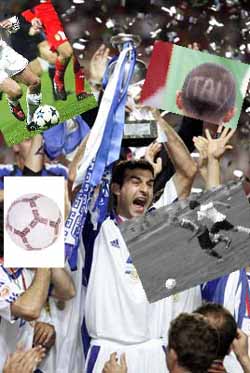 There
are any number of things that will cause popular discontent, civil unrest,
and marauding bands of pitchfork-bearing peasants to start overturning
the king's coaches on the highways. Hunger is one, as is taxation without
representation, but in Naples, getting flim-flammed out of your rightful
place in the football leagues will do the trick quite nicely. If what
happened the other day had happened at any other time of the year, there
might have been real trouble. It is no accident that the news broke
in the middle of August, when the whole city is somewhere else on vacation,
and the few stay-at-homes are sweltering in the worst heat-wave in decades. There
are any number of things that will cause popular discontent, civil unrest,
and marauding bands of pitchfork-bearing peasants to start overturning
the king's coaches on the highways. Hunger is one, as is taxation without
representation, but in Naples, getting flim-flammed out of your rightful
place in the football leagues will do the trick quite nicely. If what
happened the other day had happened at any other time of the year, there
might have been real trouble. It is no accident that the news broke
in the middle of August, when the whole city is somewhere else on vacation,
and the few stay-at-homes are sweltering in the worst heat-wave in decades.
Another
entry explains, roughly, how the Italian football leagues are set
up. At the end of last season, a couple of months ago, Naples pulled
out a couple of victories to finish near the bottom of the "B" football
league. True, that is a long, long way from the glories of the 1980s
and 90s when the team actually won the "A" league championship twice
and was a competitor in most other years, but playing in the "B" league
is a lot better than demotion to the "C" league, which is one step above
the semi-pro and amateur leagues. That would have happened had Naples
not won those few games at the end of last season. So, generally speaking,
Naples football fans were, if not happy, at least relieved.
Now comes
the news that the team is to be relegated to the "C" league for next
reason due not to anything that happened on the playing field, but to
a decision by a judge that the team's "papers" are not in order. In
order to take part in the season every year, teams are required to pay
a fee. That payment is backed by a third-person guarantor. A judge has
determined that, in the case of Naples, the document attesting to the
guarantee is invalid due to an invalid signature.
Such documents
are not mere formalities in Italian sports, and there have been cases
of entire teams being punished for irregularities. The punishment, in
this case, is that Naples is sent down to the "C" league. The open slot
in the "B" league will be filled by Catania, the Sicilian team that
was contending with Naples last season in the league standings to keep
out of last place to avoid being sent down to the "C" league. Naples
made it; Catania didn't. Those results have now been reversed by the
recent decision. Naples has a very short time—a few days—to
appeal the decision, because the playing season is about to start. The
crux of the appeal will be, one, that there was nothing wrong with the
guarantor's papers and, two, that the judge who ruled against Naples
is from Catania.
The judge
in question anticipated some of that in this morning's paper. "It is
irrelevant that I am from Catania," he says. "I'm not a sports fan.
The last time I set foot in a stadium was in 1974. I'm a judge. I apply
the law."
Lepanto,
Battle of; Santa Maria della Vittoria
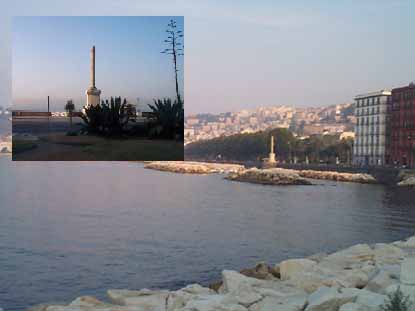 Many cities have squares, streets and monuments named
for "victory". In many cases, the victory—the particular
battle or war—is left unnamed since at their dedication
"everyone knows". It's simply "Victory Square". How could anyone NOT
know? Frailty, thy name is memory; I have checked with a number of Neapolitans
to see what they know about Piazza Vittoria (Victory Square)
at the east end of the Villa Comunale. The most common answer is, "Oh,
that's where the number 28 bus [alternately the number 1 street-car]
turns around". Occasionally, you get a vague "named for some war or
other" answer. And on rare occasion, someone knows: The Battle of Lepanto.
Technically speaking, the square is named for the Church in the square:
Santa Maria della Vittoria, which was, indeed, named for the
battle—but that's close enough. Many cities have squares, streets and monuments named
for "victory". In many cases, the victory—the particular
battle or war—is left unnamed since at their dedication
"everyone knows". It's simply "Victory Square". How could anyone NOT
know? Frailty, thy name is memory; I have checked with a number of Neapolitans
to see what they know about Piazza Vittoria (Victory Square)
at the east end of the Villa Comunale. The most common answer is, "Oh,
that's where the number 28 bus [alternately the number 1 street-car]
turns around". Occasionally, you get a vague "named for some war or
other" answer. And on rare occasion, someone knows: The Battle of Lepanto.
Technically speaking, the square is named for the Church in the square:
Santa Maria della Vittoria, which was, indeed, named for the
battle—but that's close enough.
The small
church and an adjacent monastery were built in 1572, the year following
the epic sea battle between the Turks and the Holy League, a combined
European naval force promoted by Pope Pius V. It has been called the
"last crusade," a battle not just between rival nations, but between
rival civilizations—in this case, Islam and Christianity. It was,
in every respect, as important to the survival of the West as the Battle
of Marathon, and if the Holy League had not won, nothing could have
prevented the Turks from advancing into Europe, from taking Rome, itself.
Battle
was joined on the October 7, 1571. It had been preceded by the Turkish
conquest of Cyprus in 1570, and, of course, in the previous century
by the Turkish conquest of Constantinople—the fall of the Byzantine
Empire. There was no doubt in the mind of the Pope which way the wind
was blowing. He got Venice, Genoa, Spain (and thus, Naples and Sicily—part
of the Spanish Empire at the time) to assemble a fleet of over 200 ships
to meet the slightly larger Turkish fleet south of Cape Scropha in western
Greece, near Lepanto ("Epakto" in Greek). Though outnumbered and less
manoeuvrable, the Western fleet was more modern, relying on cannon,
as opposed to the Turks, who still relied on bows and arrows and getting
in close enough to board. The losses were staggering. When the single
day was done, 85% of the Turkish fleet had been sunk and 20,000 Turks
killed; 8,000 soldiers in the Western fleet perished. The Holy League
then disbanded, Europe went back to parochial bickering, and all was
right with the world.
The Church
of Maria della Vittoria was then rededicated in the early 1600s by the
daughter of John of Austria, the commander of the Western fleet. The
monastery part of the building was vacated in the early 1800s and since
that time has been used for private residences. The square, itself,
was expanded in the 1890s as part of the Risanamento,
the great urban renewal of Naples. That construction enlarged Piazza
Vittoria up to the new street, via Caracciolo, at water's edge, and
provided a quaint, hanky-sized harbor and bathing beach (photo, above).
The beach has no real name other than the hybrid "Mappatella
Beach" (using the English term). A mappatella is a small bundle
made by drawing up the corners of a rectangular piece of cloth (which
is how you packed to go to the beach in the days before the ubiquitous
backpack or plastic sack). The small harbor has a few fishing
boats in it and is marked by a monument to those who have died at sea.
The monument is a single Roman column with the top missing (photo insert,
above) and thus is called, simply, la colonna spezzata—the
"broken column". It was found on Via Anticaglia, one of the old
main roads of Roman Naples.
Bourbons
(2)
(part 1 is here.)
| As
they say, a man who needs no introduction. This is a detail from
one of four versions of Napoleon Crossing the Alps by Jacques-Louis
David. |
 Southern
Italy had gone its own way for a thousand years, since Charlemagne's
failure to reunite the entire peninsula. It is, perhaps, a strange coincidence
that another conqueror, also doomed to fail, should set in motion the
machinery that would lead to the south being woven back into the common
fabric of Italy. Southern
Italy had gone its own way for a thousand years, since Charlemagne's
failure to reunite the entire peninsula. It is, perhaps, a strange coincidence
that another conqueror, also doomed to fail, should set in motion the
machinery that would lead to the south being woven back into the common
fabric of Italy.
Beginning
in 1800, Napoleon Bonaparte swept across Europe in a virtuoso display
of military genius, political ambition and radical social change. In
the space of four years he made himself King of France, then King of
"Italy" (a satrapy he carved out of northern Italy), and then Emperor!
In so doing he forced the official emperor to abdicate, ending the Holy
Roman Empire forged by Charlemagne. By shaping much of Germany into
the so-called "Confederation of the Rhine" in 1806 and imposing the
legal system known as the Napoleonic Code, he put an official end to
feudalism in central Europe. Militarily, he took on the rest of Europe
and at least on land was victorious at virtually every turn (his defeats
at the hands of the British at sea were crucial, however). His goal
to create a single Empire from the British Isles to the Mediterranean,
from the Atlantic to the Ural mountains failed. But it was close.
Napoleon
was impatient with the Kingdom of Naples. In a blunt letter to Queen
Maria Carolina, he told her:
"What
must I think of the kingdom of Naples … when I see at the head
of its administration a man who is alien to the country… [referring
to Acton, the prime minister]…
I have therefore decided… to consider Naples as a country ruled
by an English minister. I am loathe to meddle in the internal affairs
of other states… yet… "
With that,
and further motivated by his distrust of Neapolitan professions of neutrality
regarding French disputes with the Austrians and British, Bonaparte
sent troops into the Kingdom of Naples, forcing the royal family to
flee south again, just as during the brief period of the Parthenopean
Republic a few years earlier and again hunker down on Sicily as a separate
little island kingdom. Napoleon sent his brother, Joseph, to be
King of Naples, then juggled Joseph over to the throne of Spain and
replaced him in Naples with their brother-in-law, the dashing cavalry
officer, Joachim ('Gioacchino' in Italian) Murat.
Murat was
the King of Naples from 1808 to 1815. The Napoleonic Code transformed
southern Italy. It dismantled the privileges of the churches and the
barons, reordered the courts and set up schools for the education
of the general population. Not only in the south, but all over the Italian
peninsula, this autocratic imposition of the ideals of the French Revolution
would outlast Napoleon, himself, and would help shape eventual national
aspirations for a single nation stretching from from Sicily to the Alps.
Murat even saw himself as the future King of all of Italy and, thus,
he encouraged secret societies such as the Carbonari,
hotbeds of pan-Italian nationalism. Ultimately, with the defeat and
exile of Napoleon, Murat's fortunes crumbled. His own attempts to resist
the restoration of the Bourbons dictated by the Congress of Vienna in
1815 failed when his southern army was defeated by the Austrians. He
fled to Corsica and made one last futile attempt —truly à
la Bonaparte!— to return from exile and raise an army to retake
his kingdom. He was taken prisoner and shot.
Portrait
of Ferdinand (Royal Palace)
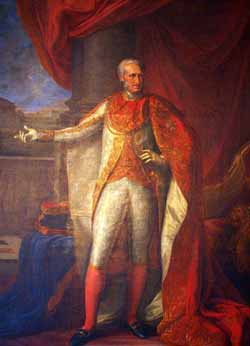 After
the restoration, the former Ferdinand IV returned as Ferdinand I of
the United Kingdom of the Two Sicilies. Times, however, had changed.
First of all, his wife, who had practically run the kingdom during the
entire course of their marriage, had died. Second, the growing middle
class of entrepreneurs, intellectuals, military professionals, and new
property owners had set their sights on representative government, a
constitution. And third, all over Italy were stirring sentiments echoed
by Manzoni's famous line: "We shall not be free until we are one." (Ironically,
he got that phrase from Cuoco, a Neapolitan
philosopher). After
the restoration, the former Ferdinand IV returned as Ferdinand I of
the United Kingdom of the Two Sicilies. Times, however, had changed.
First of all, his wife, who had practically run the kingdom during the
entire course of their marriage, had died. Second, the growing middle
class of entrepreneurs, intellectuals, military professionals, and new
property owners had set their sights on representative government, a
constitution. And third, all over Italy were stirring sentiments echoed
by Manzoni's famous line: "We shall not be free until we are one." (Ironically,
he got that phrase from Cuoco, a Neapolitan
philosopher).
But Naples
was suffering from—to use Croce's phrase—the "stamp of illiteracy',
brought about by the flight of and persecution of intellectuals, liberals
and other supporters of Murat and of the earlier Parthenopean Republic.
Now, the old lazzarone, the king who had always felt most at
home among the peasantry, no longer even trusted his own subjects to
support him. He imported companies of Swiss mercenaries to augment his army.
Ferdinand
was forced to relinquish absolute rule and grant a constitution to Naples
in 1820 as a result of a carbonari-led revolution. The last thing
he did in his life, however, was to reaffirm his spiritual allegiance
to another century by getting Austrian help to suppress the constitutional
government and carry out brutal reprisals against the leaders. He died
in 1825 after one of the longest reigns (excluding Napoleonic interruptions)
in European history, having ascended the throne in 1759. He had outlived
his wife, two capable prime ministers (Tanucci and Acton) and, quite
clearly, his time. His son, Francis I, succeeded him for a brief period
and then, in 1830, the grandson, Ferdinand II, came to the throne.
The
inauguration in 1839 of the first railway in Italy, from Naples to Portici.
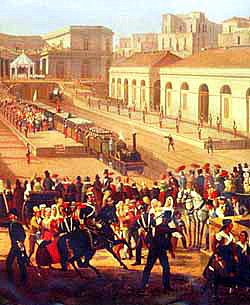 The
last thirty years of the existence of the Kingdom of Naples are marked
by great strides in science, technology and industry. The first railways
and iron-suspension bridges in Italy were in the south, as was the first
overland electric telegraph cable. Also, the fleet of the Kingdom of
Two Sicilies was the largest merchant fleet in the Mediterranean.
By 1839, the main streets of Naples were gas-lit. Ferdinand II even built the cliff-top road along the
Sorrentine peninsula. To some, such accomplishments define a sort of
Golden Age similar to that under Charles III a century earlier. Much
Bourbon achievement at mid-nineteenth century, however, was possible
only because Murat had laid the groundwork decades earlier by reforming
the university and founding various scientific academies. The
last thirty years of the existence of the Kingdom of Naples are marked
by great strides in science, technology and industry. The first railways
and iron-suspension bridges in Italy were in the south, as was the first
overland electric telegraph cable. Also, the fleet of the Kingdom of
Two Sicilies was the largest merchant fleet in the Mediterranean.
By 1839, the main streets of Naples were gas-lit. Ferdinand II even built the cliff-top road along the
Sorrentine peninsula. To some, such accomplishments define a sort of
Golden Age similar to that under Charles III a century earlier. Much
Bourbon achievement at mid-nineteenth century, however, was possible
only because Murat had laid the groundwork decades earlier by reforming
the university and founding various scientific academies.
More relevant
than industry to Naples' real future, that is, its participation —or
lack, thereof— in the struggle for Italian unity, was Ferdinand's
inability to read the handwriting on the wall. Two of his comments
bear repeating: "I don't know what is meant by an independent Italy
—I only understand an independent Naples," and "My kingdom starts
at seawater and ends at Holy Water," (referring to Sicily in the south
and the Papal States in the north). Clearly, this mentality was at odds
with nationalist sentiments of groups such as Mazzini's Young Italy,
agitating all over the north to unify the peninsula.
General
revolution in the name of constitutional government swept Europe
in 1848. In Naples, the king, like his grandfather before him,
was forced to grant a constitution. Neapolitan troops actually went
north to join the fight against the Austrians in what would become known
as the First War of Italian Unification, but they were recalled to the
south when their King, again like his grandfather, staged a counterrevolution
and revoked the constitution. At this point, thousands of intellectuals
and liberals fled north to join the struggle for "Italy." It was now
the only game in town, and they would be part of it—with their
King, if possible, but without him, if need be.
Ferdinand,
thus, denied the South the opportunity of being part of the Risorgimento,
the movement for a single Italy. He became ever more absolutist and
isolated. He died in May, 1859 and was succeeded by his son Francis
II, destined to be the last king of Naples. Although Francis tried to
stave off the inevitable by giving in to liberal demands to restore
the constitution, it was much too late for such half-measures. The Kingdom
of Naples had come full circle: founded by the Norman invasion of Sicily
eight hundred years earlier, it was about to end by another invasion
of the same island, this one led by Giuseppe Garibaldi.
[continued
at Bourbons (3)]
Mercadante
Theater
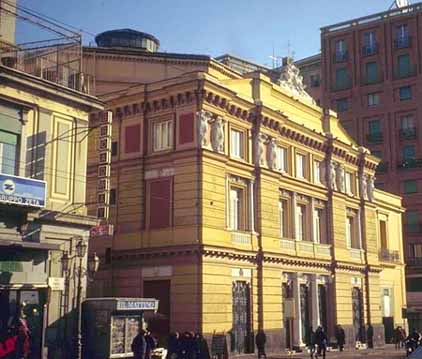 When the Jesuits were expelled from the Kingdom of Naples
in the 1770s, a fund was set up to handle the new wealth that had accrued
to the Kingdom from the confiscated property. One decision was to build
a new theater, appropriately called the Teatro Fondo (after the
"fund" that had underwritten the construction). It was inaugurated in
1779 and was intended to be more a vehicle for lighter theater, such
as the Comic Opera, and not to be in direct competition with nearby
San Carlo, generally given to more serious works. Unlike smaller, private
theaters in Naples at the time, the Teatro Fondo was sponsored by the
state; it was a "royal theater" like San Carlo and was prestigious. When the Jesuits were expelled from the Kingdom of Naples
in the 1770s, a fund was set up to handle the new wealth that had accrued
to the Kingdom from the confiscated property. One decision was to build
a new theater, appropriately called the Teatro Fondo (after the
"fund" that had underwritten the construction). It was inaugurated in
1779 and was intended to be more a vehicle for lighter theater, such
as the Comic Opera, and not to be in direct competition with nearby
San Carlo, generally given to more serious works. Unlike smaller, private
theaters in Naples at the time, the Teatro Fondo was sponsored by the
state; it was a "royal theater" like San Carlo and was prestigious.
During
the brief duration of the Neapolitan Republic in 1799, the name was
changed to Il Teatro Patriottico, and monarchist fluff such as
Comic Opera was abolished in favor of the
more politically educational fare of republican theater. Between 1809
and 1829, the theater was managed by Domenico Barbaja, who was also
the director of San Carlo. During that period, many works that one would
normally associate with San Carlo—the works of Mozart, Rossini, Donizetti,
and Bellini, for example—were
commonly performed at the Teatro Fondo.
The name
of the theater was changed to the Mercadante Theater in 1870 to honor
Saverio Mercadante, a prominent Neapolitan composer and director of
the Naples Music Conservatory, who had
just passed away. Although obscure today, Mercadante enjoyed a considerable
reputation during his lifetime and was mentioned in the same breath
as Rossini, Donizetti, Bellini and even Verdi as one of the great Italian
composers of the 19th century. His entire life was bound up with Naples;
he entered the Naples Conservatory in 1808, became the composer–in–residence
at San Carlo in 1823, the director of the conservatory in 1840, and
from 1845-55 the director of San Carlo.
For reasons
having to do with his support of the Carbonarist Revolution in Naples in 1820-1, Mercadante
left Naples for a few years and worked in northern Italy, Austria and
Spain. Reconciled with the Bourbon monarchy in Naples, he returned to
continue his career as composer and musical impresario. He is best remembered,
historically, as one who tried to revitalize Italian instrumental music
(as opposed to opera) and one who introduced Neapolitan audiences to
the music of contemorary German composers. Mercadante was held in such
high esteem that when the Kingdom of Naples collapsed before the forces
of Garibaldi, he was kept on as director of the Conservatory, where
he turned out an orchestral hymn to Garibaldi—no doubt with the
same professionalism as a year earlier when he had composed the coronation
music for Francis II, the last King of Naples.
In the
latter part of the 19th century, the Mercadante Theater gradually left
music to San Carlo and concentrated on plays and, later, vaudeville.
The theater was damaged in WW2. Now, after decades of difficult false
starts, the Mercadante has been restored and is once again in a position
to host significant contributions to the cultural life of the city.
As one sees the theater today, the façade is the redone version
from 1893, the decade of the great urban renewal
of that part of the city. Today, over 100 years later, the Mercadante
is flanked by bigger and, frankly, ugly buildings such that it now stands
out like a gem.
Garibaldi
(U.S. reaction to) (1)
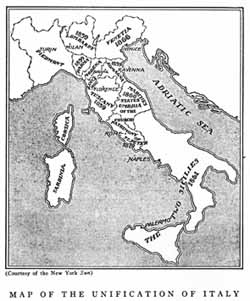 I'm
reading another one of Howard Marraro's interesting books (also see
here), this one entitled American Opinion on the Unification
of Italy, 1846 –61, first published in 1932. He stitches together
and comments upon newspaper items, magazine articles, pamphlets, and
speeches and messages of American public figures from those years to
show what the public in the United States felt, generally, about the
broad issue of Italian unity and, specifically, how it reacted to the
conquest of the Kingdom of the Two Sicilies by Garibaldi. I'm
reading another one of Howard Marraro's interesting books (also see
here), this one entitled American Opinion on the Unification
of Italy, 1846 –61, first published in 1932. He stitches together
and comments upon newspaper items, magazine articles, pamphlets, and
speeches and messages of American public figures from those years to
show what the public in the United States felt, generally, about the
broad issue of Italian unity and, specifically, how it reacted to the
conquest of the Kingdom of the Two Sicilies by Garibaldi.
Public
opinion in the United States was overwhelmingly behind the Risorgimento,
the drive to unite Italy. There was some dissent among Roman Catholics
and in the Catholic press, which knew that the unity of Italy would
mean the end of the1000-year-old Vatican States, the broad buffer zone
between northern and southern Italy, and, thus, the end of the "temporal
power of the Pope". Other than that, opinion was enthusiastically behind
Garibaldi and his daring campaign to free the long-suffering peasantry
of the Kingdom of Naples from the yoke of centuries of oppression —
(yes, just such rhetoric). It was common to see and hear Garibaldi referred
to as the "Washington of Italy," high praise, indeed, from Americans.
They sent more than their good wishes, too. Americans sent money and
even material help; a number of US citizens residing in Italy at the
time actually fought with Garibaldi, and some American merchant captains
put their vessels at Garibaldi's disposal to cross the straits of Messina
to begin his march towards Naples in 1860.
Strangely
related to that is an item I found about the recent addition to the
library of the University of South Carolina of the Anthony P. Campanella
Collection, a formidable array of material about Garibaldi. The text
describing the collection and donation contains this paragraph:
| There
can be no doubt that the March, whose progress was eagerly followed
in a United States ideologically opposed to European dynastic
"tyranny," was viewed in this country as a powerful vindication
of the right of the individual to political self-determination.
It also encouraged Southern leaders in their move towards secession
at precisely the time when accounts of Garibaldi's exploits appeared
in the American press. Nor is it coincidental that in 1876 Wade
Hampton's followers, in their resistance to the continued presence
of Federal troops in South Carolina, appropriated the name of
Garibaldi's followers—Red Shirts—for themselves. |
[The
entire item is on the internet at http://www.sc.edu/library/spcoll/hist/garib/garib.php
]
I find
at least some of that strange. I am prepared to take the word of the
gentleman who wrote those lines that there might have been something
inspiring in the heroics of the anti-tyrant, Garibaldi, something that
appealed to those in the south who felt they, too, were suffering under
tyranny—the tyranny of federalism. (Indeed, a year later, those
southerners commonly referred to their cause as The Second American
Revolution). (At the risk of being really wrong, I wonder, too,
if there is not parochialism in that paragraph. He is writing on behalf
of the University of South Carolina —South Carolina, the birthplace
of the Confederacy.)
Also, I
strain to believe that any southerners after the Civil War would
have appropriated Garibaldi's name or symbols to their lost cause. Surely,
they knew that Lincoln, in 1861, had offered Garibaldi the position
of a general in the field for the Union armies, and that the only reasons
Garibaldi turned Lincoln down were (1) that Lincoln wouldn't make him
commander-in-chief (Abe already had that job) and (2) that Lincoln wouldn't
let him free slaves wherever he found them during his military campaigns.
(Invading plantations and liberating slaves in South America had been
one of Garibaldi's favorite things to do during his younger days, when
he was abroad and training for the big fight).
Comic
opera, Neapolitan (and Mozart)
 In a letter
to his sister in May of 1770, Mozart wrote from Naples that…"An
opera composed by Jomelli begins on the 30th. We have seen the king
and queen at Mass in the royal chapel at Portici, and we have seen
Vesuvius, too… Madame de Amicis is singing at the opera. We
have been to visit her. Caffaro is the composer of the second opera,
Ciccio di Majo of the third…". In a letter
to his sister in May of 1770, Mozart wrote from Naples that…"An
opera composed by Jomelli begins on the 30th. We have seen the king
and queen at Mass in the royal chapel at Portici, and we have seen
Vesuvius, too… Madame de Amicis is singing at the opera. We
have been to visit her. Caffaro is the composer of the second opera,
Ciccio di Majo of the third…".
A
few weeks later he wrote, again to his sister, that "… the opera
here is by Jomelli; it is beautiful, but too discreet and old-fashioned
for the theater. Madame de Amicis sings incomparably… The theater
is handsome. The king …always stands on a stool at the opera
to appear a little taller than the queen. The queen is beautiful and
courteous…"
Mozart
was only 15 when he wrote those letters; he was in Naples with his father
as part of a tour of Italy to further his musical education. Naples
was of extreme interest to any composer of that period because it was
the home of the fine conservatories as well as the most beautiful theater
(San Carlo) in Europe. Also, it was the birthplace of the most popular
form of musical entertainment of the eighteenth century, the Comic Opera.
If your
view of opera is that is necessarily entails death by consumption, jumping
from high places, getting stabbed by your lover or, in the case of much
of Wagner, being pecked to death by mythologically huge swans, you will
be happy to know that such has not always been the case. Those of you
with funny bones will appreciate that the record for the longest encore
ever played at the end of an opera was a repetition of the entire work!
It was in 1792 and the work was a comic opera entitled The Clandestine
Marriage by the Neapolitan composer Domenico Cimarosa. It was premiered
at the Burgtheater in Vienna, and as noted, the Emperor liked it so
much that he ordered dinner for everyone before having the company do
the whole thing again.
By the
early 1700s, opera, the musical theater, in Europe had reached somewhat
of an impasse. It was musically confusing, unable to decide on priorities
between plot and music, often sacrificing everything to mere vocal virtuosity.
And it was often dreary, still based, as it was, on the same Greek mythological
themes that had given rise to the original melodramas of Monteverdi
a century earlier. The balance between the importance of music versus
the importance of text had shifted from text (where it been in the late
1500s) to music; that is, after a century of the powerful musical influence
of Monteverdi, there was no doubt by 1700 what was more important—music.
One thing
had to happen to keep melodrama from dying of all melo– and no
drama: restore meaningful text; give people stories they could enjoy.
One way to do this was to restore the literary value of the typical
tales of classical mythology. This happened in the person of Metastasio, the greatest Italian librettist
of the 18th century and one of the finest Italian poets of that century.
His Didone Abbandonata from 1724 marks the rebirth of real poetry
in the Italian libretto.
Another
way was to turn to more modern stories and set them to music. Enter
the Neapolitans, who began livening up evenings at the opera by inserting
light–hearted little interludes—called "intermezzos"—
between the acts of the more serious stuff. They broke up an evening
of Achilles or Ajax or Opheus with a few minutes of fluffy domestic
farce set to delightfully singable melodies. Alessandro
Scarlatti's Il trionfo dell'onore, given 18 times at the
Teatro dei Fiorentini in 1718, is chronologically the first comic
hit of this newer light-hearted fare.
From there,
an entire school of composers (see composers, other) dedicated themselves to
such music. In 1733 Neapolitan composer Giovanni Battista Pergolesi's
La serva padrona (The Maid Mistress) was produced. In 1749, some
years after the composer's death, the opera swept Italy and France,
literally revolutionizing the musical theater. (In 1741, the Comic Opera
as comic intermezzo had ended when King Charles III decided it was inappropriate
to have such folderol break up Greek tragedy. Put that stuff in a separate
theater, he said. They did, and the independent Comic Opera was born.)
In 1760, Niccolò Piccinni wrote the music to La Cecchina
on a text by the great Venetian playwright, Goldoni. That text was based
on a very popular English novel, Pamela or Virtue Rewarded, from
1740, by Samuel Richardson. Many years later, Verdi, himself, called
La Cecchina, the "first true comic opera"—that is to say,
it had everything: it was no longer simply an intermezzo; it had a real
story that people liked; it had dramatic variety; and, musically, it
had strong melodies and even strong supporting orchestral parts including
a strong, almost "stand-alone" overture (i.e. you could enjoy it as
an independent orchestral piece).
From then
until the end of the century, many of Europe's best-loved composers
were Neapolitans working within the framework of the comic opera: Pergolesi,
Paisiello, Cimarosa,
among others. Mozart had come to Naples to listen to the music of these
composers and to learn from them. He spent a short but thoroughly
enjoyable time in Naples, taking in the sights and, of course, the sounds.
He attended the opera, and he gave piano recitals of his own, during
one of which, so the story goes, the young genius was required by the
public to take off a ring he was wearing just to show that it wasn't
magic and that he could still play without it!
Like every
other musical form that Mozart touched, he perfected the comic opera,
too. His own works have so overshadowed the music of his Neapolitan
contemporaries that of the literally hundreds of comic operas produced
in Naples in the latter part of the 18th century, perhaps the only two
still in the standard repertoire of opera companies elsewhere are two
mentioned above: The Clandestine Marriage and The Servant
Mistress.
The contemporary
Neapolitan composer and musicologist Roberto de Simone has dedicated much of his activity
to reviving a number of these 'lost' Neapolitan comic operas. They are
generally well-received, but music that has to be revived will probably
never again find a permanent place in the musical consciousness of the
public. In a certain sense, we have become addicted to the passions
of Romanticism. We will never be able to listen to this delightful music
of the 18th century without first filtering it though our knowledge
of 19th and 20th century music. We'll never appreciate it the way Mozart
did when he was here. He heard it fresh, and he liked it. It was something
he could work with.
Sebeto
river
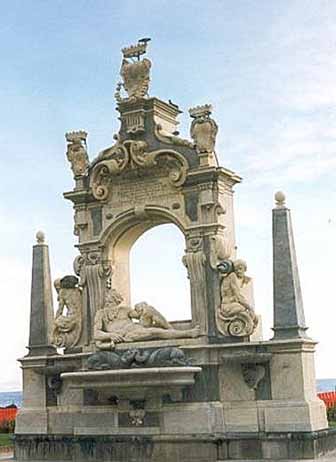 I came across a passage that read: "Perhaps only the
elderly recall the legends of love that blossomed on the shores of the
Sebeto." I asked an elderly friend (95 years old) here in Naples what
he knew about (1) legends of love and (2) the Sebeto river, which
used to flow from its source near Nola and down through the eastern
part of Naples, well outside the ancient walls, and into the sea. He
said: "That's the same line I heard when I was young. 'Only the elderly
recall the Sebeto.' I don't know a thing about it." I came across a passage that read: "Perhaps only the
elderly recall the legends of love that blossomed on the shores of the
Sebeto." I asked an elderly friend (95 years old) here in Naples what
he knew about (1) legends of love and (2) the Sebeto river, which
used to flow from its source near Nola and down through the eastern
part of Naples, well outside the ancient walls, and into the sea. He
said: "That's the same line I heard when I was young. 'Only the elderly
recall the Sebeto.' I don't know a thing about it."
References,
both classical and modern, to the Sebeto River in Naples are plentiful.
There is a Greek coin minted in Naples in the fourth century B.C. bearing
the head of the young river-god with his name, "Sepeithos". Virgil mentions
the river, as do Italian medieval writers such as Boccaccio. The Neapolitan,
Jacopo Sannazzaro, called the river "my Neapolitan Tiber". Pontano spoke
of the placid waters of the Sebeto, and Veronica Gambara (1485-1550),
one of Italy's first women poets of distinction, wrote, "Là
dove or d'erbe adorna ambe le sponde/il bel Sebeto..." ("There where
green adorns the banks of the beautiful Sebeto"). Also, near the Mergellina
harbor, there is a large, marvellous fountain (photo) dedicated to the
Sebeto. It was built by Cosimo Fanzago in 1635.
More recently,
there are hydrologic reports on the "Sebeto depression," a Sebeto literary
prize, Sebeto internet addresses, at least one Sebeto street in Naples,
a theater, a 1989 book called The Mysterious Sebeto and plans
to build a green urban park along what used to be the banks of what
used to be the river. Apparently the river still exists, at least to
some extent, as a subterranean stream since a report on the contruction
of new stations for the Circumvesuviana train-line in the extreme eastern
end of the city mentioned the problem of underground water.
The last
elderly person to recall the green banks of the Sebeto must have lived
in the mid-19th century and recalled a time before the Bourbons went on a swamp-draining binge late in the
previous century. They succeeded in drying up the marsh area near what
is now the Maddalena Bridge in the industrial section of the city. Apparently
they dried up the river as well.
Santa
Maria Francesca
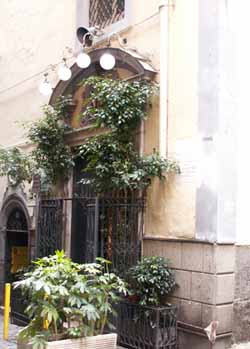 Everyone,
of course, knows that the patron saint of Naples is San Gennaro (St. Januarius), but of the six people
I've just spoken to—and I include myself in that group—not
one of us knew that Naples has a co-patron-saint. Maybe the reason for
our ignorance is that we all live up on the hill above the "real" city,
a section of Naples that is, if not well-off snooty, at least severely
gentrified. But if you get down into the Spanish Quarter, off of via Toledo, everyone knows
about Santa Maria Francesca, the only Neapolitan woman ever to be elevated
to sainthood by the Roman Catholic church. Everyone,
of course, knows that the patron saint of Naples is San Gennaro (St. Januarius), but of the six people
I've just spoken to—and I include myself in that group—not
one of us knew that Naples has a co-patron-saint. Maybe the reason for
our ignorance is that we all live up on the hill above the "real" city,
a section of Naples that is, if not well-off snooty, at least severely
gentrified. But if you get down into the Spanish Quarter, off of via Toledo, everyone knows
about Santa Maria Francesca, the only Neapolitan woman ever to be elevated
to sainthood by the Roman Catholic church.
She was
born Anna Maria Rosa Nicoletta Gallo in 1715 in Naples and died there
in 1791. She entered a religious order at the age of 16 to escape a
particularly harsh and abusive family environment. She took the religious
name of Santa Maria Francesca delle cinque piaghe (Saint Mary
Francis of the Five Wounds of Jesus). She spent the last 38 years of
her life as a "home saint," as it is idiomatically called in Italian.
That is something like a "worker priest"; that is, she did not live
a reclusive life in a convent; she lived in a private home and spent
all her time working with and for the poor in the area. She was beatified
by Gregory XVI in 1843, and canonized by Pius IX in 1867. Since the
beatification, there has been a chapel in the left nave of the Cathedral
of Naples dedicated to her. In 1856, Ferdinand II of Naples acquired
the house she had lived and died in and made it into a small church
named for the saint, the church of Santa Maria Francesca delle cinque
piaghe. It is on a street called vico tre re a Toledo in
the Spanish Quarter (photo).
That small
church made the news today because a small statue—not much more
than a doll, really—of the Infant Jesus wearing a silk garment
with threaded gold hand-sewn by St. Mary Francis, herself, was stolen
a few days ago. The aged nun in charge of caring for the object, 90-year-old
Sister Aurora, was apparently set-up: one thief distracted her with
a question, and the other thief popped the cover on the small display
case and made off with the statue. Sister Aurora has refused to eat
since then, and a second member of the order, Sister Veronica says,
"I hope this is not sinful of me, but I hope they [the thieves] find
no peace". The police and a squad from the Superintendancy of Culture
are on the case, as are members of the church congregation. It is a
rough section of town, and if this story has a happy ending, small bands
of "angels with dirty faces" will hunt down the ne'er-do-wells and give
them a heavy dose of "no peace" before returning the Baby Jesus to the
devotees of St. Mary Francis.
Salerno,
Duchy of
Sichelgaita—Warrior
Princess, and then some.
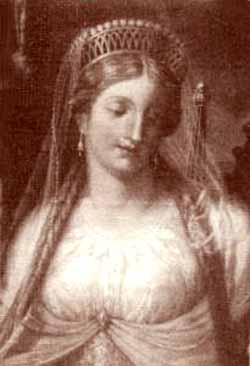 What
bizarre, zigzag chain of events—even for the Middle Ages—led
to the unlikely sight, in May, 1076, of a fair young princess, clad
in shining armor and astride her steed, riding next to her husband,
Robert of Hauteville (known as Robert "Guiscard"—the Wise), right
up to the walls of her own native city of Salerno, ruled by her own
brother, and demanding its surrender? What
bizarre, zigzag chain of events—even for the Middle Ages—led
to the unlikely sight, in May, 1076, of a fair young princess, clad
in shining armor and astride her steed, riding next to her husband,
Robert of Hauteville (known as Robert "Guiscard"—the Wise), right
up to the walls of her own native city of Salerno, ruled by her own
brother, and demanding its surrender?
Thereby
hangs quite a tale, and you can keep it straight only if you know the
cast of characters who were competing for the upper hand in Europe—and
particularly in the case of our story, southern Italy—between
the years 1000 and 1100. There are at least 5 major players. In no particular
order, they are:
1. The
Holy Roman Empire
2. The
Church of Rome
3. The
Byzantine Empire
4. The
Normans
5. The
residual Lombard duchies in southern Italy, in particular, the Duchy
of Salerno.
(1) The Holy Roman Empire was formally proclaimed in 800 with
Charlemagne as emperor. It was essentially what replaced the loose hodge-podge
of "barbarian" states occupying the former western Roman Empire. It
was the first great northern power base in Europe and was the forerunner
of individual European nation states such as France and Germany. The
Holy Roman Empire lasted until 1806 when Francis II, faced with Napoleon's
proclamation of a new empire, abdicated.
(2) By
the Church of Rome is meant here the territory of the Papal States,
taking up much of central Italy and coming into being as result of the
so-called "Donation of Pepin" in the mid-700's. That gift of land turned
the Church into a secular power with enough might to field armies and
crown emperors.
At this
point, note the "Holy" in Holy Roman Empire. The Empire and the Church
of Rome started out in a symbiotic relationship, each depending on the
other for validation or military support, depending on the times. It
is significant that Charlemagne was crowned emperor by the Pope, himself.
That event marked the end of secular Europe (pre-Europe, really) and
the beginning of large-scale involvement by the Church in continental
politics, involvement that would last until the Empire, itself, was
dismantled by Napoleon a thousand years later. The infamous Church vs
State enmity (typified by the 'Guelph' and 'Ghibelline' factions of
the 14th century) can be traced to the great reform movement within
the Church in the mid-1000s, spearheaded by the monk Hildebrand,
later to become Pope Gregory VII. His call for what amounted to a theocracy
and a totally subservient Empire alienated the "princes of the earth".
(3) The
Byzantine Empire, also known as the Eastern Roman Empire, had its
beginnings under Constantine the Great, the founder of the city in 330
that would bear his name until the fall of that city to the Turks in
1452. After the fall of Rome in 476 and even through and beyond the
Lombard rule in Italy (568-774), Byzantine forces actively contested
much of Italy and did not totally withdraw until well into the 1100s.
(4) Few
peoples have been as explosive and expansive as the Normans.
They started as Danish Vikings, the Norsemen who invaded Britain in
the mid-800s. In that same period, they marauded almost everywhere,
sacking cities from Canturbury to Paris to Constantinople; yet they
also founded lasting Russian dynasties in Kiev and Novgorod.Then, in
911, they took the area of northern France that would be named for them—Normandy.
In the late 900s and early 1000s the Vikings were sailing to Iceland
and North America; by 1015 their cousins from Normandy would be probing
southern Italy. They would then retake Sicily from the Arabs in the
mid-1000s—a very difficult struggle. They would invade and subdue
Britain in 1066. All in all, they were a swashbuckling race of
people -- and they were ambitious. Just how ambitious would not be clear
until the greatest of them, the Robert Guiscard mentioned in the first
paragraph, above, revealed his plans not just to rule southern Italy,
but to take over the Byzantine Empire and reunite the Eastern and Western
churches and, then, possibly, to move even further east as had Alexander
the Great.
(5) The
Lombards really have two histories in Italy. The first is as
the great Lombard kingdom of Italy from 568-774. They were the last
"barbarians" to invade the Italian peninsula after the fall of the western
Roman Empire and ruled much of the peninsula as a loose confederation,
contesting much of the territory much of the time with the Byzantine
Empire. That grand Lombard kingdom came to an end when Charlemagne invaded
Italy and defeated the Lombards in the north of Italy in 774.
The other
Lombard history concerns our story. Charlemagne, though calling himself
"King of the Lombards" (and annexing the north of Italy to the Holy
Roman Empire) left undefeated and largely intact the vast area of southern
Italy with its separate residual Lombard holdings, most important of
which was the Duchy of Benevento. That duchy, itself, underwent a civil
war in 839, giving birth to an independent Duchy of Salerno.
In the
course of the next two centuries Salerno developed into one of the cultural
centers of Europe. It was primarily famous for its medical school, the
first of its kind in Europe. It was here that disease became something
to be diagnosed, treated and, potentially, cured, thus adopting what
one day would be called a "scientific" approach and abandoning the Christian
monastic treatments of prayer and mortification of the flesh. Herbal
pharmacology was studied, as was anatomy and surgery --even early attempts
at anaesthesia. The school also hosted a group called the "Ladies of
Salerno", foremost of whom was Trotula, who taught about and wrote important
early works on the medical problems of women. Women studied there, as
well, and one such student was the not-yet "warrior princess", Sichelgaita.
The medical school attracted scholars from throughout Europe.
Also, given
the pre-Crusades anything-goes atmosphere of the independent ports of
commerce such as Naples, Salerno, Amalfi and Gaeta, there was surely
exchange of information --as well as goods-- between them and the Muslim
world. Wary of the post hoc fallacy of confusing sequence with
cause and effect, we may nevertheless note that there were earlier Muslim
models of modern medical schools and that the school in Salerno may
have benefited from such exchange.
So,
with that...
| The
Duchy of Salerno in the 11th century, before the Norman consolidation
of southern Italy. (From Muir's Historical Atlas, 1911). |
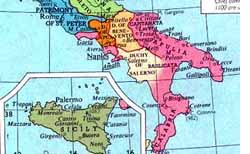
Sichelgaita
was born in 1035 into the ruling family of the Duchy of Salerno. She
was the daughter of Gaimar V, who was murdered in a palace coup. Her
brother, Gisulf, retook the Duchy, and she retook her place as the most
privileged woman in the Duchy. She spent much of her time studying medicine
and—an unlikely combination, perhaps—pursuing the "manly"
arts of horseback-riding and swordplay.
Her native
Lombard Duchy of Salerno was by 1050 already in trouble, at least potentially.
It had held the ever-encroaching Byzantine forces at bay, but the Normans
would be more difficult. The Normans had come on the southern
Italian scene in the early 1000s. Depending on the source you choose
to believe, they originally were either pilgrims who liked what
they saw and decided to stay, or they were itinerant warriors who actually
helped the Salernitans repel a Saracen (Arab) raid. The Normans were
then asked to stay and did. Or, perhaps, they were simply following
the same Norman nature that sent them out from Denmark centuries earlier,
seeking worlds to conquer. In any event, by the mid-1000s, Robert Guiscard
and a number of his Hauteville clan were firmly entrenched in the south.
They set about taking over, piecemeal, what was left of Lombard holdouts,
Byzantine enclaves, and brigand and pirate hideouts, as well as taking
on the great Arab armies on the island of Sicily.
"Guiscard"
is a by-name meaning "resourceful." Apparently, Robert was given the
name of "Viscardus" somewhat ironically by his first wife's
nephew (1) for knowing whom to marry and (2) for his uncanny ability
to know when to be ruthless and when to be forgiving. There is no doubt
that he had the rough-and-tumble Norman lust for battle, but he could
also be diplomatic. His wisdom extended to not being vindictive in war;
he was not driven by the petty need to brutalize those whom he had defeated.
You fought, you won, and you consolidated, and you do that by turning
enemies into ex-enemies and then into allies. But—here's the very
wise Robert—why wage war against a formidable enemy, Salerno,
when you could merge both your dynasties by marriage? Why not blend
the ancient, noble Lombards of Salerno with the vigorous, warrior Normans?
All you needed was a handsome, robust and willing groom—himself,
and a beautiful, robust and willing bride—Sichelgaita.
There is
no evidence that the young noblewoman, Sichelgaita, was dragged kicking
and screaming into a marriage she detested. Quite the contrary, if sources
are to be believed. Sure, it may have been an arranged marriage of convenience,
and who knows if she was truly smitten, but--for Heaven's sake! -- it
was marriage to Robert of Hauteville, that great, good-looking,
charismatic warrior and the one allmighty walker-on-water figure of
the 11th century in Italy. She, herself, was astute and knew what her
duchy stood to gain by such a union. She had seen the handwriting on
the wall, and it was all writ large in Norman French. Now, at least,
the Norman and Lombards might rule much of Italy together.
The marriage
came about in 1058. It didn't exactly enjoy the blessings of Sichelgaita's
brother, Gisulf, but he, too, was intelligent enough to know that his
duchy could use some friendly Normans in the family. He was beset by
the nearby Duchy of Capua as well as by marauding bands of very unfriendly
Normans under the leadership of Robert's younger brother, William of
Hauteville.
In order
to enter the holy bond of matrimony to his Lombard princess, Robert
had to have his first marriage annulled, which he managed to do by admitting
to incest. Robert and his first wife, a Norman, were nowhere close to
the forbidden degree of kinship that defines incest, but it was a ploy
that worked. Robert took his new, young bride off to his capital city
of Melfi.
The next
18 years of Sichelgaita's life leading up to the siege of her own home
town of Salerno were spent as a constant companion of her husband, helping
him solidify his hold on southern Italy. All accounts of her activities
report that she was his trusted advisor in affairs of state and military
matters. Also, she was very devout, which helped her smooth over Robert's
difficulties with the Church. She was genuinely troubled over the fate
of her husband's immortal soul, since he had the bad habit of getting
himself excommunicated every now and then for his devil-may-care invasions
of Papal land. Sichelgaita's diplomatic skill was crucial in straightening
out many of these thorny problems. On one such occasion, Pope Nicolas
II wound up blessing Robert as the rightful ruler of the land he had
already taken (most of southern Italy), all this in return for Robert's
oath of allegiance to the Pope and the Church.
The Church's
stance vis-à-vis the Normans in the middle of the 1000s
changed from ambiguity to support. Though Stephen IX, Pope in 1057/8,
actually proposed military campaigns against the Normans, he was followed
by Nicolas II, a believer in strong ties to these people whom he no
doubt saw as somewhat of an irresistible force. Then came
Alexander II, noted for approval of that other Norman Conquest, the
invasion of Britain in 1066. Then, of course, came Hildebrand, Pope
Gregory VII, the great reformer, friend of Sichlegaita's, a friendship
that would play a great role in the life of this Pope, one of the most
important in Church history.
The
Arechi castle in Salerno, where the Lombard surrender to the Normans
took place.
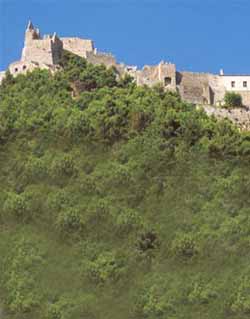 When the
time came, as it had to, for Robert of Hauteville to demand the surrender
of Salerno, the last remaining large Lombard Duchy in the South, it
was no doubt his wife who kept him from simply attacking her native
city outright. And, thus, the opening scene of this story came to pass.
Sichelgaita went into the city and begged her brother to surrender.
He wouldn't, so Robert simply lay siege to Salerno and, bluntly, starved
them out. It took months, but it was effective. Sichelgaita's had managed
to save her brother's life. He went into exile in Rome. When the
time came, as it had to, for Robert of Hauteville to demand the surrender
of Salerno, the last remaining large Lombard Duchy in the South, it
was no doubt his wife who kept him from simply attacking her native
city outright. And, thus, the opening scene of this story came to pass.
Sichelgaita went into the city and begged her brother to surrender.
He wouldn't, so Robert simply lay siege to Salerno and, bluntly, starved
them out. It took months, but it was effective. Sichelgaita's had managed
to save her brother's life. He went into exile in Rome.
Interestingly,
the fortunes of Salerno took a turn for the better under the combined
rule of Robert the Wise and hometown princess, Sichelgaita. The medical
school returned to its splendor of old when one of the great itinerant
scholars of the Middle Ages, Constantine of Carthage, called the "African",
was caught secretly wandering around the premises of the medical school,
admiring it. He had seen the great medical schools of Islam, but he
had not seen anything like this, he told Robert—at which point
Robert hired him to teach there. Also, the Lombard-Normans built a new
city wall and a new cathedral.
Robert's
grip on the south of Italy was still shakey, however. His own brothers
--even if they lacked the military might to confront him directly--
often agitated against him. It would be an error to view the Hauteville
Brothers as a united conquering army. Quite the contrary; Robert had
to be everywhere all the time, putting one brother in place and routing
a renegade baron or duke somewhere else.
His ambitions,
however, went well beyond southern Italy. Just as he had woven himself
into the old and venerable Lombard line to fix his grip on the south,
he and Sichelgaita in 1074 had arranged the marriage of their daughter,
Olympiade, into the ruling Dukas dynasty of Constantinople. Such a marriage
would set up Norman rule not just of southern Italy but of the entire
Eastern Roman Empire. It would be a force without equal in Europe. Potentially,
Robert saw, if not himself, then his children as the reuniters of the
recently splintered Christian faith. (The great Schism between the eastern
and western churches had occurred in 1054 when Pope Leo IX and the Greek
patriarch, Michael Cerularius, mutually excommunicated each other.)
There would again be a true empire, and here, some sources say, Robert
spoke of his ambitions to conquer Persia, as had Alexander.
A palace
coup in Greece, however, caused the new Byzantine dynasty to back out
of the proposed merger of dynasties. Robert would have to do it the
hard way, and it is in this adventure that Sichelgaita's reputation
as a warrior is grounded. It is true that on a number of earlier occasions
she had taken the field of battle with her husband. He trusted her to
lead his men and she did so, successfully. But the oft-told story of
the Valkyrie-like blonde berserker --the into-the-jaws-of-death princess,
charging into battle, spitting fire and railing at her men to stand
their ground and fight-- comes from her heroics at the battle of Durazzo
on the Albanian coast in October, 1081. Here the Normans set out to
do militarily what they had failed to do through the diplomacy of marriage:
conquer Byzantium.
The best
description of Sichelgaita in battle on that occasion comes from Anna
Comnena, the daughter of Alexis I Comnenus, the emperor of Constantinople
at the time of Robert's invasion. She writes of the Norman invasion
of Greece in her 15-volume history, The Alexiad, written a few
decades after the events took place. The Norman invasion was massive,
meant as it was to overthrow the rulers of Byzantium. They met forceful
Greek resistance, however, at which point the Norman advance stalled,
one front was commanded by Sichelgaita. Her men faltered, and, here,
Comnena writes admiringly of her ferocious enemy [cited in Norwich,
below in bibliography]:
| Directly
Gaita, Robert’s wife (who was riding at his side and was
a second Pallas, if not an Athene) saw these soldiers running
away. She looked fiercely after them and in a very powerful
voice called out to them in her own language an equivalent to
Homer’s words "How far will ye flee? Stand and fight like
men!" And when she saw that they continued to run, she grasped
a long spear and at full gallop rushed after the fugitives; and
on seeing this they recovered themselves and returned to the fight. |
In spite
of being badly wounded, Sichelgaita fought valiently and held her part
of the battlefield until Robert arrived with reinforcements.
The battle
was won, but the planned takeover of Byzantium had to be shelved. Matters
back in Italy commanded Robert's attention. Relations between the Papal
States and the Empire had taken a turn for the worse. There were two
reasons for this. The first was that Pope Gregory had supported this
invasion of Byzantium by a Norman force friendly to him. He saw it as
a means to bring the Eastern Church back into the fold, and a way to
stem increasing Muslim pressure on Constantinople. (The Seljuk Turks
had recently inflicted a devasting defeat on Byzantine forces, and the
Eastern emperor had already approached Pope Gregory about the possibilty
of launching a Crusade against the Muslims.) Thus, a Norman victory
would be a Papal victory --something that the Holy Roman Emperor could
not tolerate. The second reason for the sour relationship between the
Church and the Empire was Gregory's call for a theocracy in Europe,
one in which the princes and kings of the earth would be subservient
to the Church of Rome.
 Whatever
the reason or combination of reasons, the emperor, Henry IV, declared
Pope Gregory VII (photo, left) to be deposed. The emperor invaded Rome
and set up his own puppet "anti-Pope", Clement III. This situation was
dangerous for Robert in the South. He had counted on a strong buffer
state between the Holy Roman Empire and the Norman south. That buffer
was the Church State. Robert had taken great pains in his life to renew
his pledges of loyalty to the Pope and to use Sichelgaita's influence
with the Church and her great diplomatic abilities to stay in the good
graces of the Papacy. He would now have to honor his commitment of loyalty
and free the Pope from the imperial usurpers. These strategic reasons
were reinforced by his wife's closeness to church fathers. She was a
lifelong friend of the archbishop of Salerno, who was a close friend
of Pope Gregory. Robert really had no choice. Whatever
the reason or combination of reasons, the emperor, Henry IV, declared
Pope Gregory VII (photo, left) to be deposed. The emperor invaded Rome
and set up his own puppet "anti-Pope", Clement III. This situation was
dangerous for Robert in the South. He had counted on a strong buffer
state between the Holy Roman Empire and the Norman south. That buffer
was the Church State. Robert had taken great pains in his life to renew
his pledges of loyalty to the Pope and to use Sichelgaita's influence
with the Church and her great diplomatic abilities to stay in the good
graces of the Papacy. He would now have to honor his commitment of loyalty
and free the Pope from the imperial usurpers. These strategic reasons
were reinforced by his wife's closeness to church fathers. She was a
lifelong friend of the archbishop of Salerno, who was a close friend
of Pope Gregory. Robert really had no choice.
At this
point, Robert made one of his few strategic blunders—necessary,
perhaps, but a blunder, nonetheless. He simply lacked the manpower to
take a city such as Rome, defended as it was by an imperial army. To
make up for this lack, he brought in mercenaries, bands of Saracens
(Muslims) still roaming the south. Let that point sink in—he hired
Muslims to invade Rome! The strategy worked, militarily. The imperial
forces withdrew, but the behavior of Robert's troops in the city of
Rome was so outrageous that the entire populace was alienated. Gregory,
himself, was seen as a collaborator of those who were pillaging the
city, and he was forced to flee, leaving the anti-Pope still in charge.
Gregory went to Salerno, where he was welcomed as the "real" Pope. He
died there in 1085, no doubt saddened by his inability to rejuvenate
the Church with his reforms (or, at least, unaware of the great, long-term
moral influence his reign as Pope would have on later Church history).
In 1084,
Sichelgaita again went with her husband to the battlefields of Greece
to try and finish what they had started. They immediately met and defeated
a combined Venetian-Byzanine fleet in a ferocious encounter; they took
the island of Corfu and then Cefalonia. At that point, the story of
Robert of Hauteville, this greatest of Norman conquerors (his better-known
cousin, William the Conqueror, is said to have bolstered his own morale
by thinking of Robert's exploits) comes to a sudden end. After the battle
of Cefalonia, he took ill and died quickly in July of 1085. Sichelgaita
was by his side when he died, and she arranged to have his mortal remains
returned to Italy to rest in the Hauteville crypt in the Cathedral of
Venosa in Puglia.
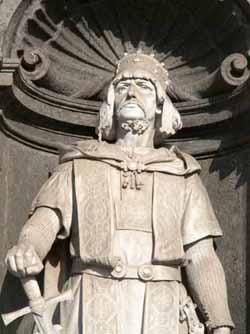 The
death of Robert left a great question mark hanging over Norman rule
in the south. None of his children had his abilities—nor should
that be surprising. The Norman campaign in Greece fizzled out. Rule
in southern Italy fell, by default, to Robert's brother, Roger I, the
conqueror of Sicily, whose son, Roger II (photo, left), would then become
the founder of The Kingdom of Sicily (later, the Kingdom of Naples).That
kingdom began in 1130 and then passed quickly out
of Norman hands to the German Hohenstaufen line.Through later dynasties,
it lasted until 1860. The
death of Robert left a great question mark hanging over Norman rule
in the south. None of his children had his abilities—nor should
that be surprising. The Norman campaign in Greece fizzled out. Rule
in southern Italy fell, by default, to Robert's brother, Roger I, the
conqueror of Sicily, whose son, Roger II (photo, left), would then become
the founder of The Kingdom of Sicily (later, the Kingdom of Naples).That
kingdom began in 1130 and then passed quickly out
of Norman hands to the German Hohenstaufen line.Through later dynasties,
it lasted until 1860.
Sichelgaita
died in March of 1090 in Salerno, the city of her birth. She had more
or less "retired" after her husband's death and spent much of her time
with her old teachers or in religious seclusion in the Abbey of Montecassino,
a place to which she had a lifelong bond and devotion. She willed that
she should be buried there.
There are
two nasty rumors about Sichelgaita: one, that she had tried to poison
her husband's son by his first marriage and, two, that she had actually
poisoned Robert, himself, after the battle of Cefalonia. She was, after
all, an accomplished student of herbal wizardry from her years at the
medical school in Salerno. Neither of these rumors is given any credence
at all by historians. It all seems to be just more medieval backbiting.
Other than
that, she comes across as somewhat low-key, living, as she did, in the
shadow of her husband, but then bursting forth at times. Her role as
a battlefield fury has lent itself to caricature over the centuries,
which is as unfortunate as it is natural. There is really nothing to
indicate that she was even very ambitious --at least not for herself.
And she was certainly neither conniving nor bent on being the power
behind Robert. She was simply an intelligent and devout woman with diverse
interests—spiritual, scientific, and military—and she was
quite willing to put her considerable skills at the disposal of a cause,
a Lombard-Norman empire. Was she a good warrior? No doubt. By all accounts,
she was a good wife and mother, too. In between her bouts of diplomacy
and battlefield heroics, she managed to bear Robert 10 children.
Bibliography:
Comnena,
Anna. The Alexiad transl. by E. Dawes. Routledge, Kegan,
Paul. London, 1928. More information on this fascinating medieval document
--indeed, the complete text of the Dawes translation-- is available
at
http://www.fordham.edu/halsall/basis/AnnaComnena-Alexiad.php
A biographical sketch of Anna Comnena, herself, is at http://www.newadvent.org/cathen/01531a.php
Also, a more recent translation (1985) by Sewter has been published
as a Penguin Classic.
Cuozzo,
Enrico. "L'Unificazione normanna e il regno normanno-svevo" in Storia
del Mezzogiorno. Edizione del Sole per Rizzoli.Napoli, 1988.
Delogo, Paolo. "Il Principato di Salerno" in Storia del Mezzogiorno.
Edizione del Sole per Rizzoli. Napoli, 1988.
Norwich, John Julius. The Normans in Sicily. Penguin. London,
1970
Pirenne, Henri. Mohammed and Charlemagne. Dover. Mineola,
2001. Reprint of 1935 edition, George Allen & Unwin, London.
Scozza, Michele. Sichelgaita, Signora del Mezzogiorno. Alfredo
Guida Editore. Naples, 1994.
Sampietrino,
stone-cutting
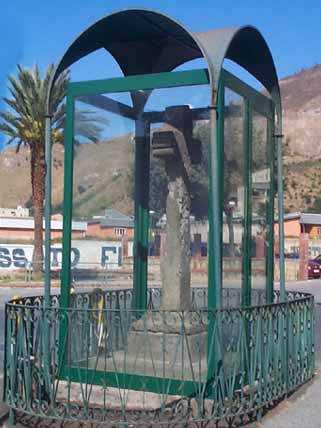 A sampietrino, in Italian. means various things:
(1) it was a coin minted by the Papal States under Pius VI (Pope from
1775-91) and was worth 2½ baiocchi, a name that apparently
derives from the northern French town of Bayeaux. I have never been
to Bayeaux, but if I go, I shall be sure to take plenty of baiocchi;
(2) it refers to a person charged with tending the premises of San Peter's
Cathedral in Rome (indeed, sampietrino means "little St. Peter");
(3) it means a cobblestone, or paverstone, cut from a dark, fine-grained
igneous rock with the geological name, in Italian, piperno —"trachyte"
in English. I don't know why these cobblestones are called "little St.
Peters," except that it might mean "a stone that looks like the kind
they used when they built St. Peter's—the kind of stone that costs
all those baiocchi." A sampietrino, in Italian. means various things:
(1) it was a coin minted by the Papal States under Pius VI (Pope from
1775-91) and was worth 2½ baiocchi, a name that apparently
derives from the northern French town of Bayeaux. I have never been
to Bayeaux, but if I go, I shall be sure to take plenty of baiocchi;
(2) it refers to a person charged with tending the premises of San Peter's
Cathedral in Rome (indeed, sampietrino means "little St. Peter");
(3) it means a cobblestone, or paverstone, cut from a dark, fine-grained
igneous rock with the geological name, in Italian, piperno —"trachyte"
in English. I don't know why these cobblestones are called "little St.
Peters," except that it might mean "a stone that looks like the kind
they used when they built St. Peter's—the kind of stone that costs
all those baiocchi."
The sampietrino—the
cobble-stone—is ubiquitous in Naples. It provides one of the two
major stone colors in the city, the other being the lighter yellow of
tufa, stone so porous that walls made from it will erode and have to
be replaced in a few decades. But piperno is durable and many
main roads are still laid by workers with small hammers, tapping one
fist-sized sampietrino after another into place, mile after mile,
and then drip-sealing the cracks with hot tar. Asphalt has made major
inroads (thank you) only with great difficulty. That will change shortly,
according to a report in the paper. Asphalt is cheaper, safer, and faster
to work with. The paper gave no date, but soon that friendly clatter
as your car slowly jars itself to smithereens over those miles of treacherous
trachyte along the port road of Naples will belong to another age.
There will
still be no shortage of sampietrini in Naples. All of the many
stairs that lead up and down the hillsides of Naples are made of Little
St. Peters, the piperno pockmarked with centuries of chisel strikes
to roughen the surface so that the stairs are less slippery in the rain
and so you don't slide those 200 meters of elevation from the Vomero
hill down to the center of town.
The dark
stone comes from hills of Naples. The suburb of Naples called "Soccavo"
sits below the height of the Camaldoli hill and takes its name from
the Latin subcavum—beneath the quarry. For centuries, stonecutters
quarried that hillside to extract not just tiny paving stones, but the
true monoliths used at the base of almost all Neapolitan monuments,
large buildings, and churches. The stone was then loaded onto ox-carts
that plodded their way into the city a few miles away. The Spanish moved
quarries well away from the city in the 17th century out of concern
for the structural integrity of the hill that much of Naples rests upon;
thus, the quarries of Soccavo closed. There is, however, still a large
cross hewn from that same material standing on a street corner in Soccavo
(photo, above). It was originally a religious object, certainly not
uncommon on the streets of Naples, but today (protected recently by
a display case) it is also, because of the material it is made of, a
monument to the bygone craft of stone-cutting. It bears the engraved
name of the artisan who made it and the date, 1613.
Vico, Giambattista
(1668-1744)
Statue
of Vico in the Villa Comunale.
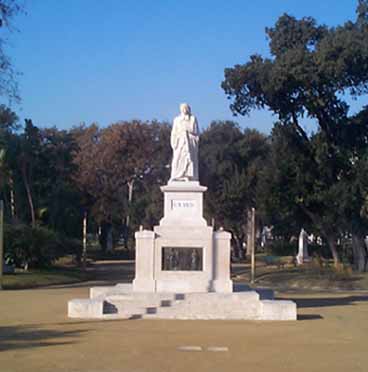 If you
were born shortly after the death of Rene Descartes, you came of age
during the great blossoming of Rationalism and the study of the natural
sciences. If you were interested in philosophy, it would not be
at all surprising if you had turned out to be a true child of
the Enlightenment, one whom history might group into that vast
body of thought encompassed by such thinkers as Descartes,
Spinoza and Voltaire. Giambattista Vico, however, did not quite fit
in with the spirit of his times, and that is precisely why he
is interesting. If you
were born shortly after the death of Rene Descartes, you came of age
during the great blossoming of Rationalism and the study of the natural
sciences. If you were interested in philosophy, it would not be
at all surprising if you had turned out to be a true child of
the Enlightenment, one whom history might group into that vast
body of thought encompassed by such thinkers as Descartes,
Spinoza and Voltaire. Giambattista Vico, however, did not quite fit
in with the spirit of his times, and that is precisely why he
is interesting.
He was
born on the street in Naples known as 'Spaccanapoli' and lived there
most of his life. After his university studies and a few years of travelling
around teaching, he wound up as a professor at the University of Naples, a post he held until his death.
His thoughts are contained primarily in his Autobiography
and in Principles of a New Science of Nations.
Vico was
at odds with the prevailing climate of the eighteenth century, which
felt that truth about the universe could be arrived at rationally.
This idea of a 'clockwork' universe, a mechanism entirely accessible
to human understanding, remained so persausive that by the late 19th
century prominent scientists were all set to dot the last 'i' of the
last law of physics and declare that discipline defunct. Then along
came our own century with such things as Relativity, Uncertainty Principles,
Quantum Indeterminacy, and Gödel's Theorem. Kurt Gödel showed
that mathematics—and, hence, logic—was not the perfect standard
of precision that it had appeared to be.
Two centuries
earlier, Vico, completely out of step with his contemporaries,
had not been comfortable with the Aristotelian ideal of perfect deduction
from first principles and had said that even mathemathics did not—could
not—contain the certainty that philosophers such as Descarte would
have liked. The so-called "truths" of mathematics were true only because
the rules governing mathematics were man-made and arbitrary. Thus,
Vico was somewhat of a harbinger of revolutionary twentieth-century
scientific philosophy.
Something
else that made Vico different from his fellow philosophers was the emphasis
he placed on the study of history.To someone like Descartes, history
was little more than a messy collection of human absurdities, hardly
the stuff worthy of true scientific enquiry. To the extent that Enlightment
philosophers worried about the nature of society, it was, again, to
discern the "natural laws" that governed human beings, just as, indeed,
natural laws governed the movement of the planets.
Vico, on
the other hand, felt that the only way to understand what we are and
are to become is to study what we have been, not by trying to mold humanity
into rigid preconceptions of what is or isn't natural. Vico believed
that societies pass through stages of growth and decay, recurring cycles
of barbarism, heroism, and reason, from whence the cycle begins again.
Each historical stage has its own kind of language: poetry, for example,
being sensuous and metaphoric, is connected with the age of heroism
(the epics of Homer, for example), while prose only enters during an
age of reason, such as our own. The study of history gives us, thus,
a certain power of prediction over our future; that was an idea that
foresaw the historical determinism of later philosophers such as Hegel
and Marx.
Even the
literature of the 20th century owes a debt to Vico, from as cumbersome
a tome as Finnegans Wake, the last page of which runs cyclically
into the first page again, all the way to the science fiction of Asimov,
whose Foundation novels are based on the premise that the proper study
of history and human behavior can be used to predict tens of thousands
of years into the future.
Child
labor; gypsies (2)
 Anyone
who spends even a few minutes looking at material from UNICEF (originally,
the United Nations International Children's Emergency Fund, but now,
simply, United Nations Children's Fund) will come away depressed and
confused. It is depressing not only that slavery still exists in the
world, but that so many bought-and-sold human pieces of property are
children between the ages of 7 and 14. UNICEF's most conservative estimate
is that there are 250 million children held in bondage in the world.
The confusing part is that it is not clear exactly what "slavery" means
in this context. I am not sure if the numbers include the thousands
of child soldiers serving in armies in some parts of the world, or the
many children who work in sweat shops but who live with their immediate
or extended families. If all that is taken into consideration, the numbers
rise towards the 500,000 mark—half a billion (!) children in bondage,
some of which —sexual slavery, for example—is perverse beyond
belief. Anyone
who spends even a few minutes looking at material from UNICEF (originally,
the United Nations International Children's Emergency Fund, but now,
simply, United Nations Children's Fund) will come away depressed and
confused. It is depressing not only that slavery still exists in the
world, but that so many bought-and-sold human pieces of property are
children between the ages of 7 and 14. UNICEF's most conservative estimate
is that there are 250 million children held in bondage in the world.
The confusing part is that it is not clear exactly what "slavery" means
in this context. I am not sure if the numbers include the thousands
of child soldiers serving in armies in some parts of the world, or the
many children who work in sweat shops but who live with their immediate
or extended families. If all that is taken into consideration, the numbers
rise towards the 500,000 mark—half a billion (!) children in bondage,
some of which —sexual slavery, for example—is perverse beyond
belief.
Given those
horrors, I suppose that the newspaper headline "A Child Slave at Every
Stoplight in Naples" has to be taken in context. The phenomenon is now
widespread in the city: young children walk up to your car and ask for
money. Some beg outright; some wipe off the headlamps (they are too
small to reach up to the windshield); and some carry signs telling you
how poor, miserable and far from home they are. It is potentially dangerous
for them; one young boy was run over at a crossing earlier this year
and seriously injured.
There are,
by my very unofficial and personal estimate, a few hundred such children
in the city. I don't think the numbers are in the thousands. A city
commission has been formed to deal with the problem, though no one knows
what that means. The children are, apparently, not slaves in the normally
accepted use of the word, since most of them seem to be under the supervision
of an adult, probably a family member—maybe a mother or big sister—who
always hides in the shade on the side of the road while the children
collect the alms—for 8-10 hours at a stretch (particularly grim
given the dangerous heat and humidity this summer in Naples).
Many of
them come from the Rom (Gypsy) encampment in the Secondigliano area
of Naples up in back of the main airport. One look inside that ramshackle
nest will put to rest any lingering, romantic notion that, well, maybe
gypsies no longer drive colorful horsedrawn wagons, but they are secretly
all well-off and, after the begging gig, sneak back home in their Mercedes
to plush mobile homes on the outskirts. There are no operattas being
played out in Secondigliano; the gypsies truly live in a pit with few
or no sanitary facilities or other amenities.
Is it illegal?
Probably. The children don't go to school; they and their families are
almost certainly in the country illegally; and the children work in
conditions that are "abusive". However, those are problems separate
from the issue of forced child labor. It is one thing to go in and free
a real slave (and there are those in Italy), maybe an Albanian child
sold to a gang or a pimp in Italy, and quite another thing for the state
to "free" children from their primary care givers, their parents, who
are making them work, and no doubt would defend the practice as time-honored
and honest. At least we are not stealing, they would say. In any event,
most drivers are ambivalent at the stoplights when a soft-eyed little
seven-year-old girl asks for money. Are you supporting child abuse?
Slavery? Are you helping them? I don't know.
de
Filippo, Peppino
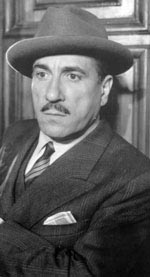 James Thurber said that humorists lead an existence
of "jumpiness and apprehension." "In the house of Life," he wrote,
"they have the feeling that they have never taken off their overcoats."
There is a lot of opinion in a similar vein, from Woody Allen's "The
trouble with writing comedy is that no one takes you seriously" to Dorothy
Parker's comment that the world is stacked against those who write humor
because anyone "has the right to read what they write and say 'I don't
think that's funny'." And Neapolitan playwright and actor, Peppino
de Filippo—the subject of these few paragraphs—said, "It's
harder to make people laugh than it is to make them cry." James Thurber said that humorists lead an existence
of "jumpiness and apprehension." "In the house of Life," he wrote,
"they have the feeling that they have never taken off their overcoats."
There is a lot of opinion in a similar vein, from Woody Allen's "The
trouble with writing comedy is that no one takes you seriously" to Dorothy
Parker's comment that the world is stacked against those who write humor
because anyone "has the right to read what they write and say 'I don't
think that's funny'." And Neapolitan playwright and actor, Peppino
de Filippo—the subject of these few paragraphs—said, "It's
harder to make people laugh than it is to make them cry."
There is
no doubt that, on an international level, Peppino de Filippo is not
as well known as his older brother, Eduardo
de Filippo, the "other" great Italian playwright (after Luigi Pirandello)
of the 20th century. That may be due to the fact—quite aside from
the much-debated existential worth of comedy as opposed to drama—that
comedy does not translate very well from language to language and culture
to culture. Yet, within Italy—and, particularly, in Naples—Peppino
de Filippo is one of the best-loved writers and actors of the last 100
years. He would have been 100 years old a few days ago (he died in 1980)
and a lot of air time on local and national television was given over
to his long career.
He made
his debut at the age of six in a play written by his and his siblings'
(Eduardo and Titina) natural father, Eduardo Scarpetta, one of the most
prominent Neapolitan playwrights of the early 20th century. Both Peppino
and his sister were part of the theatrical company formed by their brother,
Eduardo, in 1930. The company enjoyed great success throughout Italy
for well over a decade. They performed, of course, works by Eduardo,
but also some by Peppino. The company dissolved in 1944 due to a misunderstanding.
No one seems to know if it was an artistic problem, sibling rivalry
or what, but it was not amicable, and the two brothers never resolved
their differences; they led totally separate careers, Eduardo as the
great playwright and Peppino as a comic actor and minor playwright destined
to remain in the shadow of his older brother. Peppino traveled and worked
internationally, and his comedies were well received.
In films,
he is best remembered for a popular series in which he is teamed with
Totò, certainly Italy's most popular comic of the last century.
It would not be fair to call Peppino a "second banana" in these films,
but his career does seem to be one in which he is always struggling
by being compared to someone else. Outside of Italy, he is probably
best remembered for his role in the Fellini segment of Boccaccio
70 called "The Temptation of Doctor Antonio" in which Peppino plays
the prudish and repressed professor who is scandalized by and obsessed
with a gigantic billboard ad for milk featuring a gigantic and very
milky-looking Anita Ekberg.
Scarlatti,
Alessandro (1660-1725)
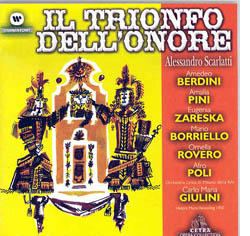
I
was reading the biographical entry on "Alessandro Scarlatti" in
an encyclopedia the other day. It was much shorter than it should
have been, finishing up with, "He is remembered as the founder of
classical music and of the harmonic system later perfected by Mozart".
Such a laconic throwaway line right at the end starts you reading
the next entry (on "Scarlet Fever," as I recall) before the full
impact of that statement really sinks in. Then-- wait …the
"founder of classical music"! Shouldn't that at least be followed
by something like, "…and He saw that it was good and He rested"?
It
is relatively easy to find something familiar and enjoyable in literature
and painting from the year 1600 —Shakespeare and Rubens, to
name but two from an incredibly long list. Yet, music from that
year presents some problems. All those things which are familiar
and likeable to the average concert-goer today —the symphony,
the concerto, the opera, the orchestra, itself— did not yet
exist in 1600, and only a music historian, a specialist, would be
able to discern in the music that Shakespeare and Rubens surely
must have listened to, the ancestor of Mozart, Beethoven and Wagner.
It is only
in the 1600s, with the development of the Italian opera by Claudio Monteverdi
and his contemporaries, that we find music opening to the commercial
world beyond the confines of the church and gaining the impetus for
the development of new forms, new instruments and new concepts of melody
and harmony. Alessandro Scarlatti stands at the end of this period.
He is, briefly, the summing up of the entire tradition of Italian music
to that time. He inherited a music that did not yet know the forms we
accept today as "classical"—the symphony, the concerto, etc.—
a music that had still not even settled on our modern harmonic and melodic
concepts of major and minor, and a music with meager instrumental resources,
to say the least. He left as his heritage advances in the modern opera,
the beginnings of the symphony and a decidedly modern direction for
harmony and melody; also, by including horns and woodwinds in the orchestra,
he laid the foundation of the modern symphony orchestra.
He was
born in Palermo, but spent much of his active life as a composer in
Naples and Rome. He was one of the most prolific composers in history,
writing 20 oratorios, 600 chamber cantatas, 200 masses, suites for various
instrumental combinations and 150 operas! His division of operatic overtures
into "movements" was the forerunner of the modern symphony, and his
single comic opera, The Triumph of Honour, performed in Naples
in 1718, paved the way for the later comic operas of Pergolesi, Cimarosa,
Paisiello, Rossini and Mozart.
Goethe's
remark that "architecture is frozen music," certainly applies to the
great German composers of the Baroque. One can easily see in the mind's
eye cathedrals lofting and arching on high to the music of Bach and
Haendel. Yet, much of Scarlatti's music is just as "cathedralesque,"
if you will. He was, however, an extremely versatile composer, and therein
lies his fascination to the student of music history, even today. For
while the Baroque side of him spired heavenward right alongside his
German colleagues, the Enlightenment, after all, had dawned, and its
attendant musical expression required fewer cathedrals and more architecture
of human dimension. Scarlatti's attention to the grace of newer and
less ornamental forms set the stage for classicism, and his sense of
melody, and even his sense of humor, imbued his art with the kind of
musical humanism that would one day be the hallmark of Romanticism,
itself.
Paestum
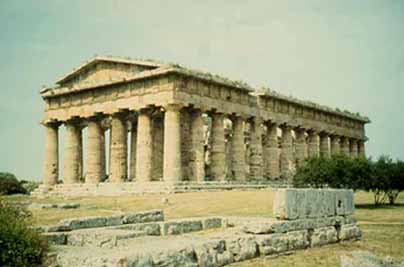 A short drive south of Naples will bring you to Paestum
and, a few miles later, Agropoli. At Paestum you have the opportunity
to visit one of the most prominent and easily accessible of the
sites in Italy that, along with Cuma, Elea (Velia) and many others here
in the south, made up Magna Grecia,
that magnificent extension of Classical Greek civilization beyond
the waters of the Aegean half a millennium before Christ Then, on the
same outing, you can drop in on the Byzantine fortress town of
Agropoli. A short drive south of Naples will bring you to Paestum
and, a few miles later, Agropoli. At Paestum you have the opportunity
to visit one of the most prominent and easily accessible of the
sites in Italy that, along with Cuma, Elea (Velia) and many others here
in the south, made up Magna Grecia,
that magnificent extension of Classical Greek civilization beyond
the waters of the Aegean half a millennium before Christ Then, on the
same outing, you can drop in on the Byzantine fortress town of
Agropoli.
The ruins
of Paestum that you see today as you drive along the length of SS 18
about fifteen miles past Battipaglia give only the faintest idea of
what a great Greek city in those days must have been like. First of
all, the area is known—from the discovery of pottery fragments—to
have been visited many centuries before even the famous Greek city-builders
by travelers from as far east in the Aegean as myth-shrouded Troy. Certainly
the Mycenaean Greeks must have been among
these. In any event, when it came time for Sybarite settlers—from
Sibari, another Greek colony to the south near modern-day Taranto—to
seek greener pastures, they chose the shores of southern Italy at a
point where the Sele river flows into the Tyrrhenian Sea, the southern
part of what is today called the Gulf of Salerno.
They founded
their city of Poseidonia (named for the Greek god of the sea, the Roman
"Neptune") on this fertile plain in around 600 BC. Interestingly, they
didn’t seem to care about the total absence of any nearby high
ground on which to build an acropolis, the "high city" typical of so
many other Greek settlements. Perhaps the mythology and aura of magic
already linked to the area was a factor in their decision. Here they
built a city, relying on walls instead of high ground for defense; the
walls were three miles in circumference, and the ruins of the four gates
are still visible: Porta Aurea, Porta della Giustizia,
Porta della Sirena, and Porta della Marina.
Entrance
to the vast archaeological site is directly from the main road, SS 18.
The most obvious ruins to be seen are those of three large temples.
The southernmost one is the Doric Basilica; it was probably dedicated
to Hera, wife of Zeus and queen of the Gods; there is a sacrificial
altar in front of the temple. Next to this temple stands the so-called
Temple of Poseidon; its simply-fluted, heavy columns are the best preserved
examples of classic Greek Doric architecture left in the world, including
ruins in Greece. The third large temple left standing is the one erected
to Ceres. All three of these structures are from the sixth century BC.
Perhaps,
indeed, because of its lack of strategic terrain, Poseidonia had a relatively
short history as a Greek city. It carried on commerce with the great
Etruscan cities of the north, but then in the fourth century BC was
conquered by the Lucanians, one of the indigenous Italic peoples
of the peninsula and the one whose name this region, Lucania, still
bears. These people, like everyone else at the time in Italy, were then
gobbled up in turn by the mighty Romans. The Romans strengthened the
walls of Poseidon —Paestum, by then—and added baths,
more temples and an amphitheater, turning the place into a typical Roman
outpost of luxurious sybaritic self-indulgence. (That was nice, since
Sybarites had founded the city in the first place!) In any event there
are also Roman bits and pieces to be seen as you stroll across the wide
abandoned meadows of Paestum.
Over the
centuries since the fall of the Roman empire, Paestum was invaded by
nature, which turned the plain into an on-again, off-again swamp,
and then overrun by Saracens, the fierce Muslim pirates from the south
who raided along these coasts in the eighth and ninth centuries a.d.
As an archaeological site, Paestum is scarcely a few centuries old,
having been rediscovered in the early 1700s along with Pompeii, Herculaneum
and so many other relics of Classical Italy. There is a fine modern
museum right across from the main entrance on SS 18; it contains the
obvious Greek and Roman relics, but also a considerable collection of
prehistoric items from the area.
A few minutes
to the south is Agropopli. The name—clearly from Greek acropolis—does,
indeed, mean "high city," but there is no evidence at all that the town
is any older than the century following the fall of the Roman empire.
The hill upon which the nucleus of the original town sits was probably
first inhabited in the fifth century AD by Byzantine forces who were
contending for Italy with great numbers of Goth invaders sweeping
down the peninsula at the time. Two things stand out about Agropoli
today. One is the Saracen castle, built by the Byzantines. That term,
"Saracen castle" or "Saracen tower," is used throughout the coastal regions
of southern Italy to describe hundreds of structures built between the
time of the first Arab incursions in Italian waters, in the eighth century,
and as late as the 1500s by the Spanish rulers of the Kingdom of Naples,
on guard against Turkish marauders. Through the centuries, the term
has generally meant a lookout, a place to watch for Saracens —after
so many centuries, simply a generic term for "Muslim pirates."
Interestingly, the Saracen castle in Agropoli was actually inhabited
by Saracens—and for quite a number of years (from 882,
when they took it from Byzantines, to 1028 when they were finally expelled
by the Normans). Remains of Arabic inscriptions attest to the Saracen
presence in Agropoli.
The other
interesting point about Agropoli is the fact that the original city,
the area high on the hill surrounding the fortress is still inhabited.
In fact, there are even ‘for-rent’ signs, evidence perhaps
of the town’s significant renaissance in the age of mass tourism.
After all, there are good beaches nearby, so why not hole up for a summer
high on an ancient fortress hillside? The castle, itself, is now a private
home, museum and convention center of sorts. You can visit it by just
ringing the bell, thus bidding the lord of the manor to grant you entrance.
(If that doesn’t work, threaten him with your cross-bow. A small
fee will also do nicely.) You can do the obligatory drawbridge and dungeon
routine—failing, of course, to keep your merlons and crenels straight—and
then stop and rest, still high on the hill and sheltered by the bulwarks
of the castle, itself, at one of the pizzerias and restaurants that
the inhabitants have seen fit to add in the last 1,500 years. Then,
meander down to the newer parts of town on the lower slopes, appreciating
how urban expansion must have changed as castles on high ground
gradually lost their strategic importance.
|
